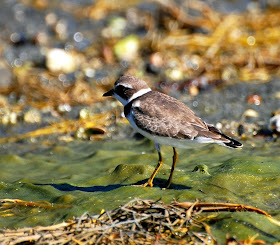Last weekend my wife and I took a little mini vacation to the South Hills of Idaho in search of a very unique finch. The South Hills Crossbill (
Loxia [
curvirostra]
sinesciurus) is an endemic species or subspecies that is found only in two isolated mountain ranges in southern Idaho. It has been described in the scientific literature as a full species, but so far the
American Ornithologists' Union and the American Birding Association have yet to adopt this change, so it is currently considered a subspecies of Red Crossbill (
Loxia curvirostra). Many people have speculated that this is only temporary, though, so last weekend we set out to put a lifer species "in the bank" in case of a future split.
There are lots of great resources online about the South Hills Crossbill, and I don't intend to repeat all that information here. Briefly, the crossbill evolved from a fascinating ecological situation where the symbiotic relationship that keeps cones easy to access in the presence of squirrels breaks down in these isolated squirrel-free mountains, resulting in an evolutionary arms race between well-defended Lodgepole Pines and specially adapted crossbill bills. The
original paper is a great reference, but summaries are also available
here and
here, for example. Rather than reiterate the details of ecology and identification that have been published better elsewhere, I will provide here the story of my search, in hopes that it will help others find this cool bird.
 |
| In November, the road to the crossbills was snowy but plowed. My little Toyota made it just fine, but I was glad to have the chains on. Don't park on the shoulder like I did - despite the very wide road, the sheriff came by and made me move my car to a parking lot. |
We started by driving up Rock Creek Road into the South Hills. From I-84 take Exit 182 and head south. Just after you cross the river gorge, turn left onto 3800E. This becomes Rock Creek Road and takes you right into the hills and up to the crossbills! Watch the landscape change as you ascend, first valley agriculture, then sagebrush, then junipers, and finally Lodgepole Pines. These pines are the preferred habitat of the South Hills Crossbill.
 |
| Beyond the Diamondfield Jack Campground, the road was not plowed, but we could still walk it. Snowshoes would have been helpful. A local told us that the road is usually plowed beyond this point. |
When we visited (in late November), the road was plowed to Diamondfield Jack Campground but not beyond. Despite the plowing, I was glad to have snow chains for the tires, but a four-wheel-drive vehicle would have probably been fine without them. We had crossbills several times between the ski area and the Diamondfield Jack Campground, always perched in the top of Lodgepole Pine or flying over, calling in flight.
 |
| If you're looking for South Hills Crossbills, you're looking for this: their preferred habitat, Lodgepole Pine. |
I suggest studying the calls well, because South Hills Crossbills are not the only crossbill type present. Better yet, make some audio recordings and study the sonograms to be absolutely sure you got the right birds.
 |
| Is this a South Hills Crossbill? It sure could be--it was foraging on Lodgepole Pine in the South Hills. But, I only recorded audio from two individuals in this flock of nine birds, and both of those ended up being Type 2, "Ponderosa Pine Crossbills." |
 |
| Fortunately, my audio recordings confirmed that several other crossbills we saw and heard were indeed South Hills Crossbills, a lifer subspecies that will potentially be a lifer species some day! |
Overall, we had three types of crossbills, including multiple individuals of our main target. Good luck if you go, and be sure to enter your sightings in
eBird!








.JPG)










































